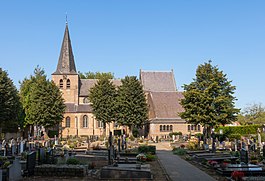Eersel
Eersel | |
|---|---|
Municipality | |
 Eersel municipal hall | |
|
UTC+2 (CEST) | |
| Postcode | 5511–5525 |
| Area code | 040, 0497 |
| Website | www |


Eersel (Dutch pronunciation: [ˈeːrsəl] ⓘ) is a municipality and a town in southern Netherlands in the province of North Brabant. Eersel is situated in the Campine (Kempen) area.
Eersel is part of the Acht Zaligheden (Eight Beatitudes) and known for its attractive market. This market, together with the Hint, has been declared a protected village on October 19, 1967. This has been done to guarantee the future survival of its authentic character.
The spoken language is Kempenlands (an East Brabantian dialect, which is very similar to colloquial Dutch).[4]
Population centres
History
About 3,500 years ago the first inhabitants of the area of Eersel were builders of sepulchre hillocks or
The Franks established themselves round 700 again in the region. They lived where high and lower grounds were laying close to each other. One of those high grounds was Ereslo. As from this time there is a form of government authority in this area. The Franks build their farms around a triangular square. This kind of settlement was called a domain which was the property of the high nobility of the Franks.
The oldest known written indication of Eersel is found in the manuscript Codex Aureus of Echternach (or Liber Aureus) of the Abbey of Echternach. In this document is a charter included in which a certain Aengilbertus, son of late Gaobertus, with approval of his brother Verengaotus gives the property of the domain Eresloch to Saint Willibrord. In this registration of the year 712 the name of ‘Ereslo’ was transferred wrong to ‘Eresloch’. Wilibrord on his behalve gave the heritage to the Abbey of Echternach in Luxembourg. To approximately in the year 1000 Eersel belonged to the
Around the 14th century Eersel became prosperous and the monumental tower of Eersel was built, together with those of Steensel and Duizel. In 1464 between the market and ‘het Hint’ a chapel was built in Eersel.
After the Middle Ages the region became more poorly and the villages did not grow between 1500 and 1800. This is the period of the ‘Teuten’ a traveling trading people, who were touring from village to village with artisan and merchant services, like coppersmith, wig-maker, also some veterinary surgeon like horse, ram, bull and pig castrating, and trade in goods like pottery, kitchen-utensil, bed-clothes, linen, lace, silk and other textile manufactures. They were no gypsies but build their homes in a central place like Eersel and traveled to other regions and lands from there. One of the remainder of this time are the houses of the ‘Teuten’ at the market. In 1800 at the time of King Willem I there came some improvement. The provincial road to Eindhoven and the road to Postel was hardened and a steam tram railway was manufactured. (1897)
In 1923 Eersel absorbed the former municipality of
Places of interest
- The church of Saint Willibrord
The original version of the church of Eersel was a simply wooden cottage and was possibly founded by the (
- The Chapel of Our Lady of Campina
It is built in 1464 in Gothic style and is the oldest building of the market. After the Peace of Münster it was closed for mass service and was used as Council house, as prison and repository for the fire-engine. It was used for 300 years as a townhall up to 1948 before it was returned to the church and used as a chapel again.
The church was built first in 1812, and has been rebuilt in 1861. It is a simple barge stone build church. The ceiling has an arbor, what gives it a very good acoustic.
Notable residents
- Bertus Borgers (born 1947 in Vessem) a Dutch saxophone player
- Wil van der Aalst (born 1966 in Eersel) a Dutch computer scientist and academic
Gallery
-
De Markt van Eersel (gemeente en plaats)
-
Kapel begraafplaats kerk Vessem
-
Eersel
-
Overzicht beekherstel - Vessem
References
- ^ "Kerncijfers wijken en buurten 2020" [Key figures for neighbourhoods 2020]. StatLine (in Dutch). CBS. 24 July 2020. Retrieved 19 September 2020.
- ^ "Postcodetool for 5521AW". Actueel Hoogtebestand Nederland (in Dutch). Het Waterschapshuis. Retrieved 11 May 2014.
- ^ "Bevolkingsontwikkeling; regio per maand" [Population growth; regions per month]. CBS Statline (in Dutch). CBS. 1 January 2021. Retrieved 2 January 2022.
- ISBN 9012090105
- ^ Ad van der Meer and Onno Boonstra, Repertorium van Nederlandse gemeenten, KNAW, 2011.
External links
 Media related to Eersel at Wikimedia Commons
Media related to Eersel at Wikimedia Commons- Official website
- Geschiedenis Eersel





